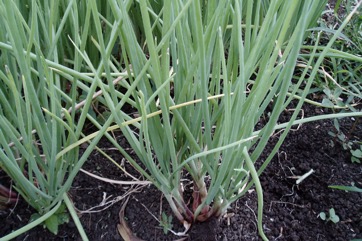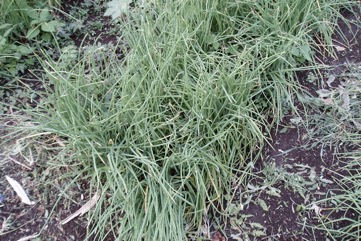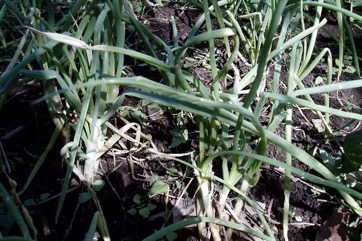Shallot

A tropical plant. In Nepal it is grown between 500 and 2000 m altitude. It does best in fertile, well-drained sandy soil. Prefers a pH in the range 6 to 7, but tolerates a pH in the range 4.5 to 8.3. It tolerates a range of soils but does best in light well drained soils.
Also known as:
Aka wakegi, Albasa, Alubosa, An-yaba, Anyenze, Basale, Bawang merah, Brambang abang, Chhyapi, Chota piaz, Doakhom, Elewe, Gandana, Gundhun, Hyeene, Hanh huong, Hom daeng, Irravengayam, Irulli, Jungli piyaj, Khtim kraham, Kon tsung-tau, Kyet-thun-ni, Rathu-lunu, Ratu-lunu, Sabala sopradaa, Sabolai, Safa, šalotka, Samana sabola, Shalamta, Siba, Sibuyas, Sinna vengayam, Sjalot, Te anian, Tongolomadinika, Varasa, Yabas, Yabasi
Synonyms
- Allium carneum Willd.
- Allium fissile Gray
- Allium hierochintinum Bossier
- Porrum ascalonicum (L.) Rchb.
Edible Portion
- Leaves, Bulbs, Flowers, Vegetable
Where does Shallot grow?
Found in: Africa, Asia, Australia, Brazil, Cambodia, Africa, Central America, Chile, China, Croatia, East Africa, East Timor, Ethiopia, Fiji, Ghana, Guyana, Himalayas, India, Indochina, Indonesia, Japan, Kiribati, Malaysia, Myanmar, Nepal, Nigeria, Pacific, Philippines, SE Asia, Singapore, South Africa, Southern China, Cuba, Czech, Slovakia, Dominican Republic, East Africa, East Timor, Egypt, Europe, Fiji, Finland, France, Germany, Ghana, Guatemala, Haiti, Hawaii, India, Iraq, Indonesia, Kurdistan, Madagascar, Malawi, Malaya, Mexico, Myanmar, Nauru, Nigeria, North Africa, North America, Pacific, Panama, Papua New Guinea, PNG, Peru, Rotuma, Salvador, Scandinavia, SE Asia, Serbia, Sierra Leone, Slovakia, Slovenia, South America, Spain, Sri Lanka, Thailand, Timor-Leste, Tonga, Trinidad, Turkey, United States, USSR, Vanuatu, Venezuela, Vietnam, West Africa, Zambia, Zimbabwe
Notes: There are about 300-700 Allium species. Most species of Allium are edible (Flora of China). All alliums are edible but they may not all be worth eating! Root (Fresh weight) Water: 79.8 Calories: 72 Protein: 2.5 Fat: 0.1 Carbohydrate: 16.8 Fibre: 0.69999 Ash: 0.8 Calcium: 37 Phosphorus: 60 Iron: 1.2 Sodium: 12 Potassium: 334 Vitamin A: 0 Thiamine: 0.05999 Riboflavin: 0.01999 Niacin: 0.2 Vitamin C: 8 They have also been put in the family Alliaceae.
Growing Shallot
Cultivation: Plants can be grown from seed or by using bulbs. The clumps are uprooted and divided. Plants are spaced 15-20 cm apart. Bulbs are planted to half the bulb depth.
Edible Uses: Both the bulbs and the leaves can be eaten as a vegetable. The bulbs are eaten raw or cooked. The leaves are eaten raw or cooked. The flowers are used raw or to flavour salads.
Production: The first leaves can be harvested after 2-3 months. The plant is easier to grow than onions, matures faster and keeps better, though yields are lower. Plants are very tolerant of high temperatures up to 30°C and bulbing only occurs at temperatures above 20°C. Plants rarely produce viable seed in temperate areas, they are usually propagated by means of their bulbs, each one dividing up in the growing season to produce from 2 to more than 12 new bulbs.
Nutrition Info
per 100g edible portion| Edible Part | Energy (kcal) | Protein (g) | Iron (mg) | Vitamin A (ug) | Vitamin c (mg) | Zinc (mg) | % Water |
|---|---|---|---|---|---|---|---|
| Leaves - raw | 72 | 2.5 | 1.2 | 119 | 8 | 0.4 | 79.8 |
| Bulbs | 59 | 1.8 | - | - | 2 | - | 84.3 |
| Flowers | - | - | - | - | - | - |
Shallot Photos



References
Abbiw, D.K., 1990, Useful Plants of Ghana. West African uses of wild and cultivated plants. Intermediate Technology Publications and the Royal Botanic Gardens, Kew. p 38
Ambasta S.P. (Ed.), 2000, The Useful Plants of India. CSIR India. p 28
Barrau, J., 1976, Subsistence Agriculture in Melanesia. Bernice P. Bishop Museu, Bulletin 219 Honolulu Hawaii. Kraus reprint. p 54
Bianchini, F., Corbetta, F., and Pistoia, M., 1975, Fruits of the Earth. Cassell. p 84
Burkill, H. M., 1985, The useful plants of west tropical Africa, Vol. 5. Kew.
Burkill, I. H., 1966, A Dictionary of the Economic Products of the Malay Peninsula. Ministry of Agriculture and Cooperatives, Kuala Lumpur, Malaysia. Vol 1 (A-H) p 99
Epenhuijsen C.W. van., 1974, Growing Native vegetables in Nigeria. FAO Rome, p 29
Facciola, S., 1998, Cornucopia 2: a Source Book of Edible Plants. Kampong Publications, p 5
Fl. palaest. 12. 1756 (perhaps to be attributed to Strand)
Fowler, D. G., 2007, Zambian Plants: Their Vernacular Names and Uses. Kew. p 64
Grubben, G. J. H. and Denton, O. A. (eds), 2004, Plant Resources of Tropical Africa 2. Vegetables. PROTA, Wageningen, Netherlands. p 35
Hadfield, J., 2001, The A-Z of Vegetable Gardening in South Africa. Struik p 135
Hedrick, U.P., 1919, (Ed.), Sturtevant's edible plants of the world. p 33
Hutton, W., 1997, Tropical Herbs and Spices of Indonesia. Periplus. p 51
Jiwajinda, S., et al, 2002, Suppressive Effects of Edible Thai Plants on Superoxide and Nitric Oxide Generation. Asian Pacific Journal of Cancer Prevention, Vol 3, 2002
Kiple, K.F. & Ornelas, K.C., (eds), 2000, The Cambridge World History of Food. CUP p 1890
Lazarides, M. & Hince, B., 1993, Handbook of Economic Plants of Australia, CSIRO. p 13
Manandhar, N.P., 2002, Plants and People of Nepal. Timber Press. Portland, Oregon. p 81
Martin, F.W. & Ruberte, R.M., 1979, Edible Leaves of the Tropics. Antillian College Press, Mayaguez, Puerto Rico. p 201 (As Allium ascalonicum)
Molla, A., Ethiopian Plant Names. http://www.ethiopic.com/aplants.htm
Ochse, J.J. et al, 1931, Vegetables of the Dutch East Indies. Asher reprint. p 441
Omawale, 1973, Guyana's edible plants. Guyana University, Georgetown p 71
Plants for a Future database, The Field, Penpol, Lostwithiel, Cornwall, PL22 0NG, UK. http://www.scs.leeds.ac.uk/pfaf/
Rajapaksha, U., 1998, Traditional Food Plants in Sri Lanka. HARTI, Sri Lanka. p 280
Smith, A.C., 1979, Flora Vitiensis Nova, Lawaii, Kuai, Hawaii, Volume 1 p 147
Solomon, C., 2001, Encyclopedia of Asian Food. New Holland. p 340
Terra, G.J.A., 1973, Tropical Vegetables. Communication 54e Royal Tropical Institute, Amsterdam, p 19
Tindall, H.D., & Williams, J.T., 1977, Tropical Vegetables and their Genetic Resources, International Board for Plant Genetic Resources, Rome, p 60
van Wyk, B., 2005, Food Plants of the World. An illustrated guide. Timber press. p 48
Walter, A. & Lebot, V., 2007, Gardens of Oceania. ACIAR Monograph No. 122. p 223
Williamson, J., 2005, Useful Plants of Malawi. 3rd. Edition. Mdadzi Book Trust. p 20
Wiriadinata, H., Ethnobotany of Economic Plants in the Baliem Valley, Jayawijaya, Irian Jaya, Indonesian Institute of Science, Bogor, Indonesia
World Checklist of Useful Plant Species 2020. Royal Botanic Gardens, Kew